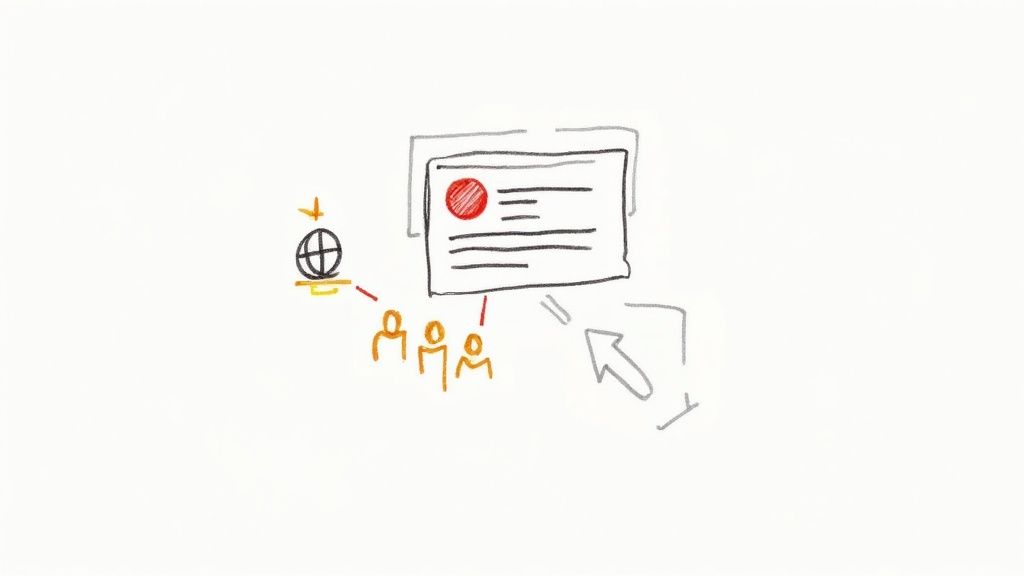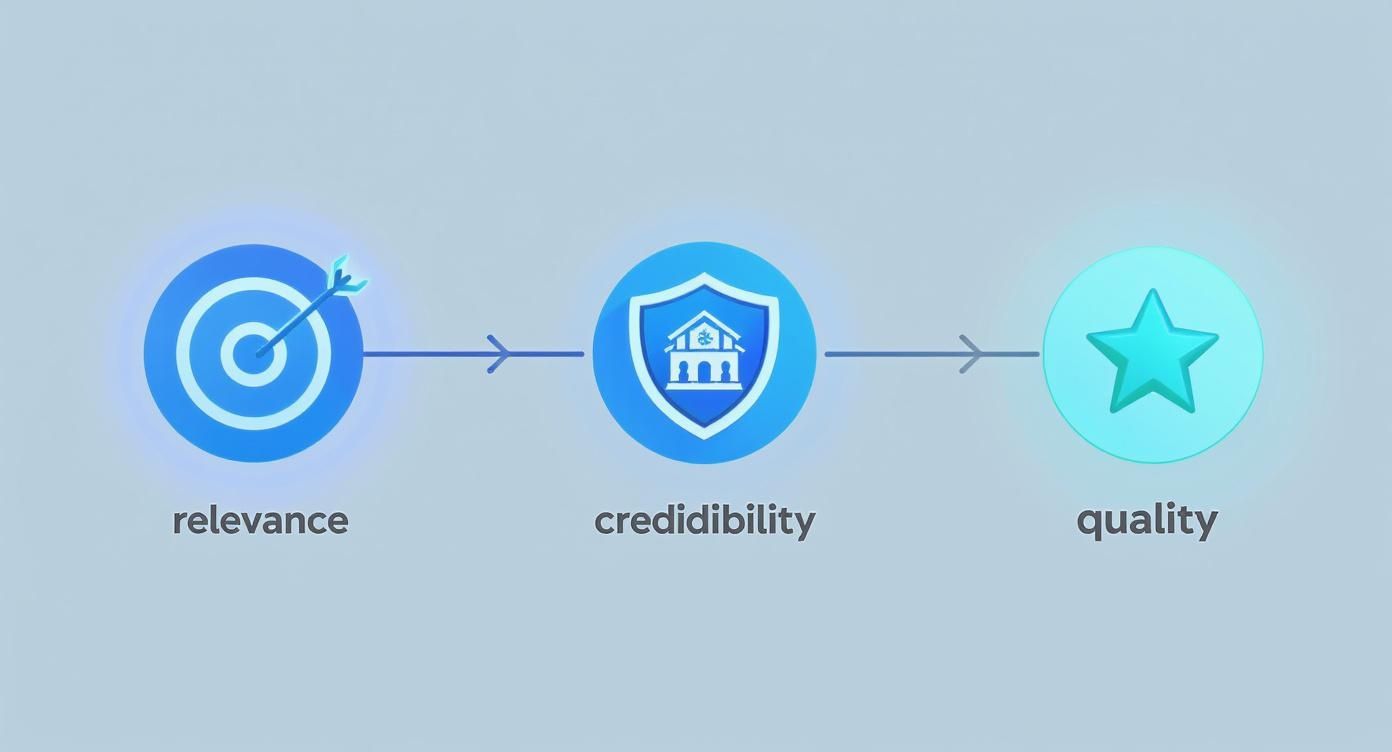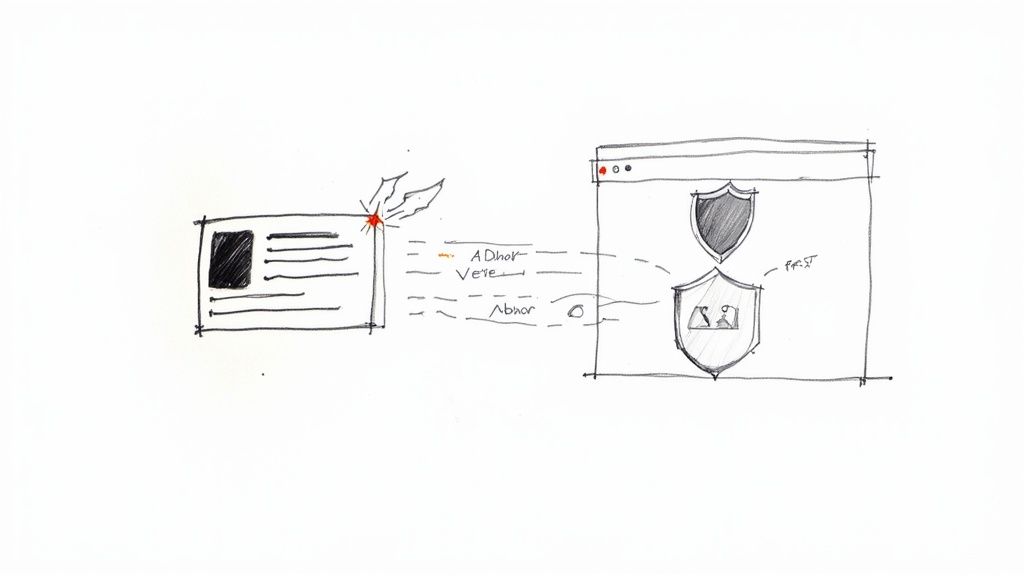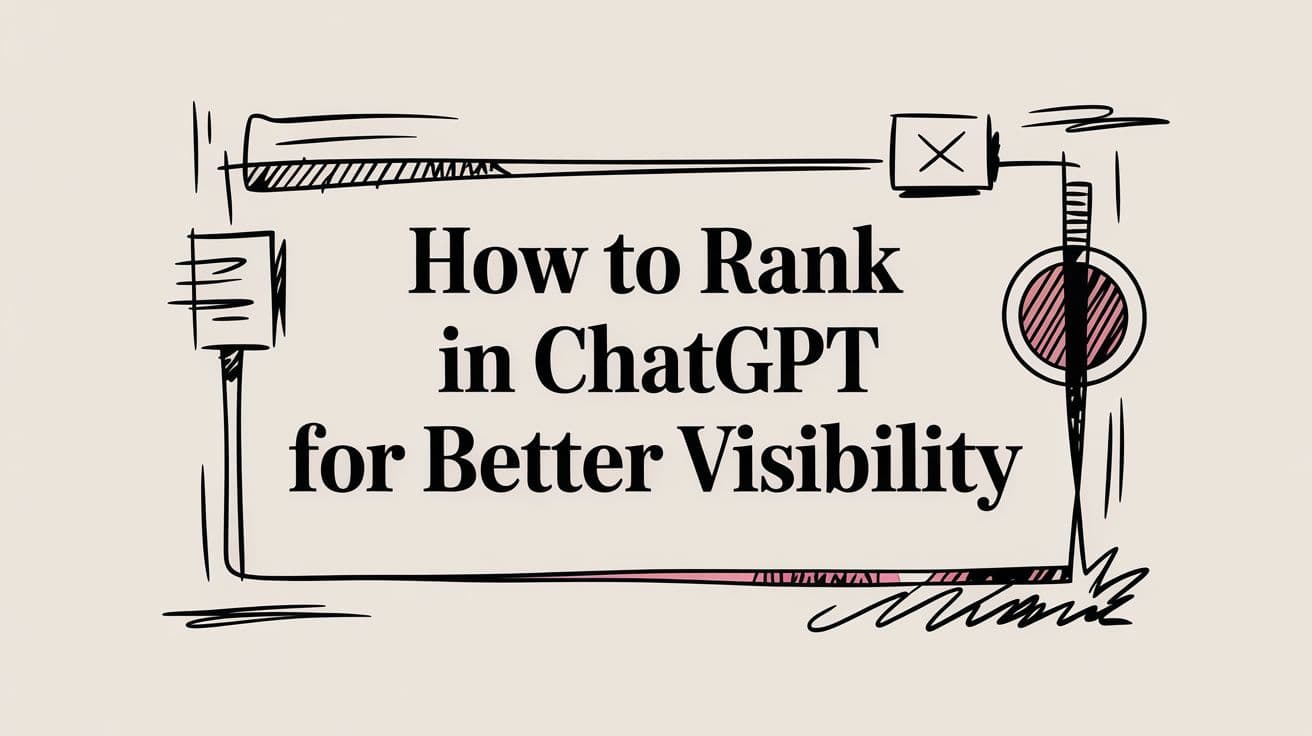Ranking in ChatGPT isn't about keywords. It's about becoming a trusted source for direct answers. If you want your brand cited in an AI-generated response, you need to create authoritative, clearly structured content that models can parse and trust. This is a different game, one that rewards precision and credibility over old-school SEO tactics.
Why Getting Cited by ChatGPT Is Crucial Now

Showing up in ChatGPT responses isn't a future trend. It's happening now and directly shapes how customers discover and perceive your brand.
Thinking of it as just another search engine is a mistake.
It’s an answer engine.
That distinction changes everything. Users aren't looking for ten blue links; they want a single, confident solution. When someone asks, “What’s the best project management tool for a small remote team?” they expect a direct recommendation, not a research project.
If your brand isn't part of that answer, you're invisible.
The Scale of the AI Answer Revolution
The numbers behind this shift are massive. ChatGPT now handles an estimated 1.6 billion monthly visits as of early 2024, according to SimilarWeb.
This isn't just passive traffic.
These are high-intent users actively seeking recommendations, solutions, and expertise. Being cited in an AI-generated answer is like receiving a direct referral from a trusted expert. It cuts through the noise of traditional search and places you in front of a motivated buyer.
From Keywords to Intent-Driven Conversations
The biggest change is the pivot from keywords to intent. Traditional SEO often means chasing broad terms. AI SEO is about satisfying the specific needs buried in conversational prompts.
This requires a different content strategy.
You need to focus on what I call the three pillars of getting cited by AI. Here’s a quick breakdown of what matters most.
The Three Pillars of Getting Cited by AI
A summary of the key factors that influence how content is surfaced and prioritized within ChatGPT's responses.
| Pillar | Why It Matters for AI Visibility | Actionable Tip |
|---|---|---|
| Direct Answers | AI models need to extract clear, concise information to answer a user's prompt directly. Vague or buried content gets ignored. | Start your articles with a direct answer to the core question. Use short paragraphs and bold key takeaways so the AI can easily grab them. |
| Demonstrated Authority | The AI must trust your content. It looks for signals of credibility, like data, citations to reputable sources, and clear expertise. | Back up claims with statistics and link out to authoritative studies or sources. An "About the Author" section also helps build trust. |
| AI-Friendly Structure | The way you format your content is critical. Clean headings (H2s, H3s), lists, and a logical flow make your content digestible for AI crawlers. | Use bullet points for lists and features. Break down complex topics with clear, descriptive subheadings that guide the AI through your logic. |
This shift in focus—from keywords to these three pillars—is the key to improving your AI search visibility. Instead of targeting "email marketing software," an AI-first approach creates content that directly answers, "Which email marketing software has the best automation for e-commerce stores?"
Get this right, and you’re no longer just optimizing for clicks. You’re optimizing to become the definitive answer.
How ChatGPT Selects Its Information Sources
To get cited by ChatGPT, you have to abandon the old SEO playbook. This isn't a search engine crawling the web for a list of links. It's a language model generating a single, synthesized answer based on patterns from a massive dataset.
It doesn’t "rank" pages.
Instead, it pulls information from sources it deems credible to construct the best possible answer. Your job isn't to climb a results page; it's to become an indispensable, trusted source the AI relies on to build its answers.
Relevance Is More Than Keywords
ChatGPT’s main goal is to answer a question precisely. It looks beyond simple keyword matching and into semantic context and user intent.
For instance, a prompt like “best CRM for a small real estate team” isn’t just a search for “CRM.” The AI understands the nuances: “small team” means affordability and ease of use are key, while “real estate” points to features like lead tracking and client management.
The model is constantly asking: "Does this content truly solve the user's underlying problem?" If your article just lists CRM features without connecting them to a real estate team's workflow, it will be ignored.
Credibility Is the Price of Admission
After relevance, credibility is the next big hurdle. An AI model is designed to avoid spreading misinformation, so it actively hunts for signals that a source is trustworthy.
This is where many brands stumble. They create relevant content but fail to prove they're a credible source.
Here’s what the AI looks for:
- Strong Citations: Are you linking out to reputable studies, established companies, or academic research?
- Transparent Authorship: Is there a clear author bio with credentials? Does the website have a detailed "About Us" page that doesn't sound like corporate fluff?
- Consistent Information: Is the brand's information consistent across the web—on LinkedIn, in industry directories, and on its own site?
Think of it like building a case. The more evidence you provide that you're an expert, the more likely the AI is to trust what you have to say.
Logical Structure and Data Freshness Matter
Finally, the AI prefers content that's easy to parse and up-to-date. A well-structured article with clear H2s and H3s is like a roadmap, helping the model quickly find the exact information it needs.
Data freshness is another major factor. For topics where timeliness is critical—like tech recommendations or market stats—the model will heavily favor content with recent publication or update dates. An article from 2021 about the "best software" is ancient history compared to one updated last month.
Understanding the broader technology helps. The field is known as conversational AI. For a solid primer, see this guide on What Is Conversational AI and How It Works. Knowing what the AI can "see" from your page is half the battle. Our AI Page Inspector helps you see what ChatGPT sees, revealing structural gaps that might hold you back.
How to Structure Content for AI Comprehension
AI models don’t read content like we do. They parse it. They hunt for structure, clarity, and direct answers. To get cited by ChatGPT, you need to stop writing for human scanners and start structuring for machine comprehension.
Your formatting is as critical as your words.
The goal is to make your content the path of least resistance for an AI hunting for a reliable source. A cluttered, dense article is a dead end. A clean, logically structured one is a goldmine.
This infographic breaks down the simple, three-step flow ChatGPT follows when it selects information: Relevance, Credibility, and Quality.

If you don't nail all three components—in that specific order—your chances of being cited plummet.
Use Headings as AI Signposts
Think of your H2s and H3s as road signs for the AI. They must be descriptive and tell a story on their own.
- Good Heading: "How to Calculate Customer Lifetime Value"
- Bad Heading: "Your Customer's True Worth"
The first heading tells the AI exactly what information follows. The second is ambiguous. Clear, declarative headings make your content instantly indexable for specific queries.
Write One Idea Per Paragraph
Long, dense paragraphs are poison for AI comprehension. The model is trying to extract a single, citable fact. When you bury that idea in a wall of text, you make its job harder.
Stick to this rule: one core idea per paragraph.
Keep paragraphs short, just one or two sentences. This forces you to be concise and makes your key points stand out, ready for an AI to grab.
The easier you make it for an AI to find and extract information, the more likely your content is to be chosen as a source. Brevity isn't just for human attention spans; it's for machine efficiency.
Create Citation-Ready Answers
Your content needs to be filled with direct, "citation-ready" sentences. These are concise, self-contained statements that directly answer a common user question.
| Human Search vs AI Answers Content Structure | | :--- | :--- | :--- | | Content Element | Traditional SEO Focus | AI Answer Engine Focus | | Headings (H2, H3) | Keyword-rich, appealing to scanners | Declarative, answer-focused signposts | | Paragraph Length | Varied, often 3-5 sentences | Ultra-short, 1-2 sentences per core idea | | Specificity | General explanations to cover keywords | Hard data, specific numbers, technical terms | | Sentence Structure | Engaging, varied prose for human readers | Concise, self-contained "citation-ready" statements | | Sourcing | Links to related articles for context | Citations to authoritative data, studies, and experts | | Language | Persuasive, often uses brand voice | Factual, direct, and unambiguous |
Adopting this AI-centric structure doesn't mean your content becomes robotic; it just becomes more direct.
Case Study 1: Monday.com Gets Specific for Project Managers
- Prompt: "What is the best project management tool for a small remote team?"
- Why Monday.com gets cited: Their content doesn't just say "we help teams collaborate." It provides specific details like, "Monday.com offers over 200 pre-built templates for remote workflows, including sprint planning and client onboarding, and integrates with Slack and Zoom."
- The Lesson: The AI latches onto the specific number (200) and the named integrations (Slack, Zoom) as proof of its utility for the target user. For more advice on this, learn about structuring your content for AI comprehension and zero-click wins.
Case Study 2: Wirecutter Details the Nitty-Gritty of Tech
- Prompt: "What's the most durable carry-on luggage?"
- Why The Wirecutter (a New York Times company) gets cited: They don't use vague terms like "high-quality." Instead, their reviews state: "The Travelpro Platinum Elite is the most durable because its ballistic nylon exterior resists abrasions, and its MagnaTrac spinner wheels survived our 50-mile stress test over cobblestone."
- The Lesson: Technical specifics like "ballistic nylon" and "MagnaTrac wheels" serve as credible evidence that the AI can trust and repeat. For a deeper look into optimizing your pages, check out our guide on SEO for AI.
By structuring your content this way, you are building a database of clear, authoritative answers that ChatGPT can easily access and trust.
Build Authority Signals That AI Models Trust

Trust is the core currency for AI answer engines. If ChatGPT can’t verify you're a credible source, your content will be ignored.
Building this trust isn't about gaming an algorithm. It's about demonstrating real-world expertise in a way a machine can understand. AI models hunt for tangible signals of authority, both on your website and across the web. These signals tell the AI that your information is reliable.
Your On-Page Signals Are Your Foundation
Everything starts with your own website. You must make it obvious to any visitor—human or AI—who is behind your content and why they should be trusted.
Here are the essentials:
- A Well-Defined Author Bio: Every article needs a clear author byline linked to a detailed bio. This bio should lay out their credentials, experience, and link to professional profiles like LinkedIn. Anonymous content is a massive red flag for AI.
- A Comprehensive 'About Us' Page: Your "About Us" page can't be an afterthought. It needs to tell your story, introduce your team, and state your mission clearly. This page is a primary source for an AI trying to understand your organization’s expertise.
- Accessible Contact Information: A legitimate business is easy to contact. Providing a physical address, phone number, and a clear contact form shows you're a real entity, not a faceless content farm.
These elements are structured data points that AI models actively seek out to verify a source's legitimacy.
External Citations Are Your Proof
Once your on-page foundation is solid, the focus shifts to off-page signals. What other reputable sources say about you matters far more than what you say about yourself.
AI models place immense weight on citations from established, authoritative websites. A single mention on a respected industry publication is more valuable than dozens of links from unknown blogs. The model learns to associate your brand with the topics discussed on these high-authority sites.
If a well-regarded site like CNET mentions a specific laptop, the AI learns that this laptop is a credible option. Your goal is to get your brand into those same conversations within your niche.
Measure Your AI Performance and Refine Your Strategy
You can’t improve what you don’t measure. In the world of AI answer engines, performance measurement is a whole new ballgame. There’s no Google Analytics for ChatGPT, and there are no static ranking lists.
Success means consistently showing up in answers for high-intent prompts. Your goal is to build a reliable feedback loop. This means testing prompts, measuring if you get cited, and then tweaking your content based on what the AI prioritizes.
Set Up Your Core Prompt Set
First, define what you're tracking. Develop a focused set of 15-20 core prompts that represent the most valuable questions your customers are asking. These aren't just keywords; they're the full questions your ideal buyers would type into an AI chat.
A solid prompt set should include a mix of query types:
- "Best of" Prompts: "What is the best accounting software for freelancers?"
- "How to" Prompts: "How do I create an invoice for a client for the first time?"
- "Comparison" Prompts: "What is the difference between FreshBooks and QuickBooks for a small business?"
- "Problem/Solution" Prompts: "Which tool can help me track my business expenses easily?"
These prompts become your benchmark. Run them regularly to see if your brand appears and which sources the model trusts.
Use a Dedicated AI SEO Tracker
Checking dozens of prompts by hand is slow and tedious. A dedicated tool is essential. Using an AI SEO Tracker automates the process, giving you structured data instead of random snapshots.
These platforms run your core prompts on a schedule, log the responses, and pinpoint which sources get cited. This uncovers your AI Share of Voice—a metric showing how often you appear in answers compared to competitors. According to a 2024 analysis by FirstPageSage, tracking these citations is non-negotiable, as AI-generated answers are expected to influence a significant portion of online commercial queries.
The AI's knowledge base is constantly being updated. A consistent tracking schedule—weekly or bi-weekly—is the only way to spot trends and react quickly.
Analyze the Gaps and Refine Your Content
Once you have the data, the real work begins. Your tracking tool won't just tell you if you were cited, but it will give you clues as to why you weren't.
Look for patterns in the content that is getting cited:
- What sources is the AI citing? Are they well-known industry blogs, big review sites like G2, or even forum discussions on Reddit?
- What kind of content is being pulled? Does the AI favor listicles with hard data, direct Q&A formats, or detailed case studies?
- What language does the AI use? Pay close attention to the exact phrasing and technical terms in the generated answers.
This is the essence of a successful refinement loop. For a deeper look at optimizing your pages, explore our guide on SEO for AI.
Where to Go From Here
Getting your content cited by AI is not a one-time fix. It’s a strategic shift toward creating clear, authoritative, and machine-readable content.
Here are your next steps:
- Audit Your Top 5 Pages: Review your most important articles. Rewrite your headings to be direct questions or statements. Break down long paragraphs. Bold the single most important insight in each section.
- Strengthen Your 'About Us' and Author Pages: Add specific credentials, years of experience, and links to professional profiles. Make your expertise undeniable to both humans and AI.
- Start Tracking 10 Core Prompts: Identify the ten questions your customers are most likely to ask ChatGPT. Use a tool like AI SEO Tracker to establish a baseline and monitor your visibility over time.
This approach moves you from chasing keywords to becoming the definitive answer.
Ready to stop guessing and start measuring your AI visibility? AI SEO Tracker shows you exactly where your brand appears in ChatGPT, Gemini, and other AI answer engines. Discover the prompts your customers are using and track your AI Share of Voice.

